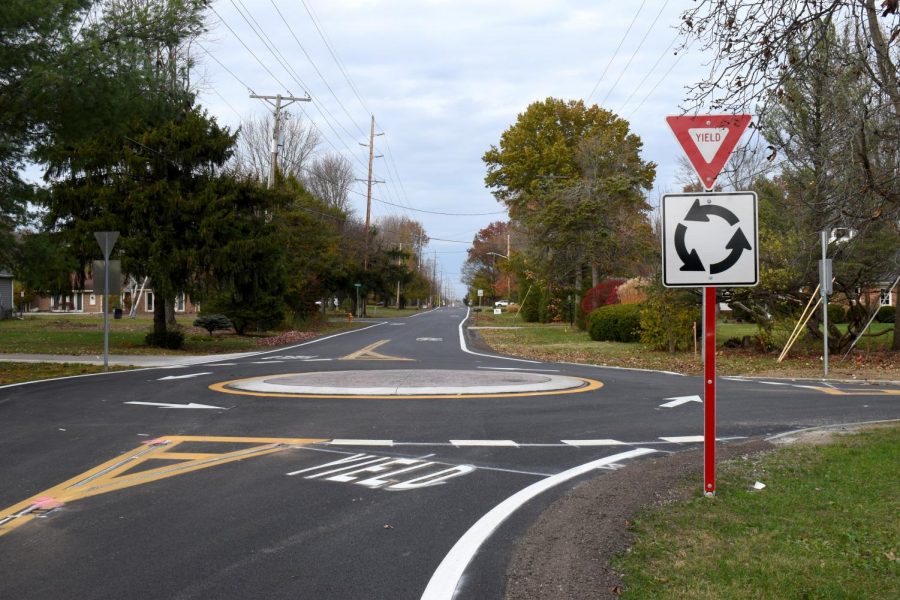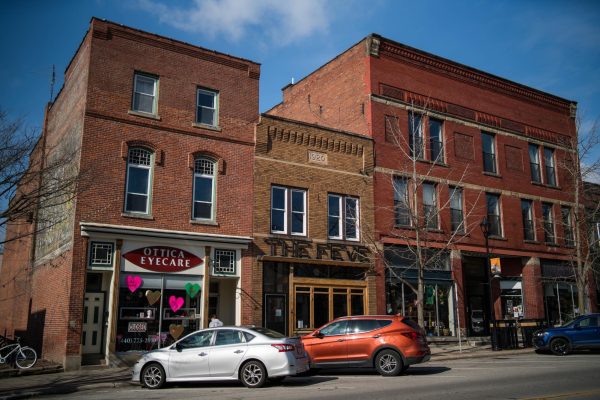Residents Respond to Construction of Pyle South Amherst Road Roundabouts
A newly-installed roundabout on Pyle South Amherst Road in Oberlin.
After almost a year of planning and discussion between residents and city officials, four roundabouts on Pyle South Amherst Road were completed last Friday. The roundabouts were part of a larger repavement project that also included cement stabilization, resurfacing, the addition of pavement markings, new signage, a golf cart crossing.
The project began after Public Works Director Jeff Bauman applied for and received an Ohio Public Works Commission grant to repave the 20-year-old pavement. This project’s cost of $720,270 was not totally covered by grant funding. According to Bauman, the roundabouts cost somewhere between $70,000 and $90,000.
The repaving sparked some concerns among those living on Pyle South Amherst, explained City Engineer Randall Roberts.
“There [were] concerns with the residents that once it had been resurfaced, speeding would be even more of an issue,” Roberts said, noting a plethora of potholes along the road. “Roads are smoother, people go faster.”
In response to this concern, members of City Council, city planning officials, and residents living on Pyle South Amherst brainstormed several ideas to mitigate the problem of speeding. These ideas included speed bumps, elevated speed tables, increased police enforcement, and “rumble strips” — grooves in the road that make noise and vibrate when they are driven over.
Ultimately, on June 3, City Council voted to approve the roundabouts idea, with five council members voting for and two voting against. City Councilmember Kelley Singleton opposed the roundabouts.
“I wasn’t positive that this was the best result that we could’ve come up with,” Singleton said. “I was concerned [about] how it was going to affect residents and their driveways … especially if you live right next to one, you might have to back your car up into a roundabout.”
Further, Singleton noted that the execution of the roundabouts did not line up with the original drawings of the roundabouts.
“I was more comfortable when I saw the final plan — unfortunately, right now, what’s out there is not what the plan that we passed was,” Singleton said. “It doesn’t look the way that the drawing looked. … The roundabouts are not centered. They’re cockeyed. If you’re going around one way, you can just keep your speed and just go right through it. If you’re going the other way, you have to slow your car down almost to an idle to go around these tight turns.”
Some additional concerns have been voiced following the completion of the roundabouts. Roderic Knight, professor emeritus of ethnomusicology, lives on Pyle South Amherst, near one of the roundabouts.
“I was involved in the community discussions about improving our street a year ago when we learned it would be resurfaced,” Knight wrote in an email to the Review. “Some months later I heard, only by word of mouth, that mini-roundabouts were being proposed. I was against them from the start and spoke several times at City Council meetings this past spring. … I am actually in favor of traffic circles (the proper term), but [think] that they are totally unsuitable for our location.”
Knight believes that there is not enough traffic on the street to warrant these roundabouts.
“I have actually been monitoring [the traffic] today, for four hours,” Knight wrote. “The count is approximately 15 vehicles total (cars, trucks, delivery vans), per hour … Most drivers follow the markings, veering to the right, then left, through a dangerously tight curve to do so. Others simply drive straight over the barely-raised circle in the street. By my count, approximately 25 percent of the southbound vehicles opt for going straight over, or left of center.”
Other residents also disapproved of the roundabouts, with one putting up a sign that read “Someone actually thought this roundabout was a good idea! It wasn’t anyone living here. Thanks to Oberlin City Council for ignoring its constituents.”
Bauman is more hopeful about the future of the neighborhood.
“We think that in combination with the [potential] future addition of sidewalks that it will make it feel a whole lot more like a neighborhood than it has previously, where you basically had a one-mile-long stretch of road that you could damn near see from end to end, so people went fast,” Bauman said. “I’ve been up and down the street a bunch of times and it’s pretty clear to me that you can’t drive, you know, 45 mph from end to end like you used to be able to do.”
Moving forward there continue to be conversations about additional infrastructure improvements in the area, though some residents have expressed opposition towards the idea of sidewalks.







